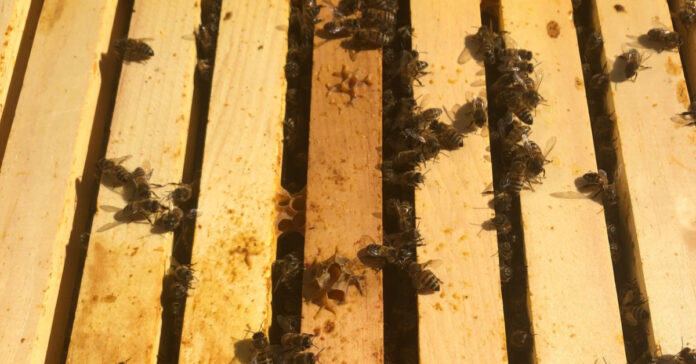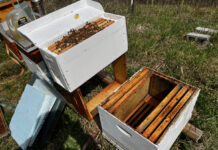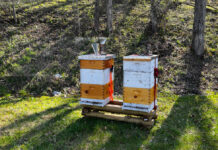As the temperatures creep up, I waited until the warmest, sunniest part of the day and visited my beehives. Two of them had bees on the landing board. One of them did not. Uh oh, that’s not a good sign, especially after at least a month of intense cold weather and high winds. I decided I better check inside the hives. This would mark the first time I’ve cracked them open since I fed the bees around Christmas.
We are expecting temps in the 50s on Friday, so I mixed up a small batch of 1-to-1 sugar water to feed my bees and grabbed a pollen patty. Just in case, I tossed on my bee jacket, but I didn’t zip it up or put on the veil.
I decided to get it over with and tackle the hive with no active bees first. I unbuckled the ratchet strap holding the hive together and lifted the outer cover and the layer of insulation, exposing the inner cover. No bees were visible through the hole. Another bad sign. I removed the inner cover and there were no bees on the top of the frames. It was looking like this hive might be a deadout. I would be lying if I said I wasn’t disappointed because this was the hive that had yielded the most honey last year.
Then a bleary-eyed bee peeked its head out between the frames and looked at me, as if to say, “Hey, we’re down her trying to sleep and you’re causing a draft!” She was joined by another bee, who glared at me. I secretly celebrated the fact that this hive was still alive, if not thriving, and slapped third of a pollen patty on the frames near the bees and put the inner cover back on. Then I added a hive-top feeder and gave them a half inch of sugar water. That should allow them to feed when it is warm enough to do so.
Hive Number 2
The second hive I opened was more active. Not only could I see the bees through the hole in the inner cover, but a couple flew up at me when I removed it. (I didn’t have my smoker because I figured it was so cold the bees would not be active.) I flipped my veil on and quickly threw down a pollen patty. There were enough bees on the frames that I had to brush them out of the way to put the patty down. Then I filled their feeder, reassembled the hive, and tightened up the ratchet.
The third hive I opened, which is technically Hive Number 1, also had more bees in it than I expected, as you can see in the photo. This had been my smallest hive going into the winter, but so far it has outperformed what was my strongest hive. I fed these bees sugar water and the rest of the patty.
If the weather allows, I will go back in next week and see if they consumed all or most of the patty. If so, I’ll feed more.
Feeding my Bees
As I wrote once before, I am a strong believer in feeding my honey bees. I consider them livestock, and just like I feed my chickens, I consider it my responsibility to feed my bees. Feeding them at specific times of year also results in a healthier hive, improves the odds of the hive overwintering successfully, and helps improve my honey harvest by increasing the number of worker bees available to harvest nectar during the spring flow.
Feeding sugar water is also important if you are trying to help bees through the winter or encourage a new or growing hive to build out frames with fresh beeswax. I feed pollen patties in the spring to help the hives ready themselves for the early nectar flows.
Why Pollen Patties
The presence of protein coming into the hive as pollen tells the queen that it is OK to lay eggs. The continued availability of protein allows the nurse bees to provide sufficient royal jelly to the larvae and then continue to feed them until they become capped brood. Should there be a sudden lack of pollen, the hive may kill its larvae and cannibalize them as a source of protein. Feeding pollen patties ensures they won’t do this. If I left it up to nature, egg laying would start later.
It takes three weeks for a worker bee egg to go through the developmental stages of larvae and pupae and emerge as a new bee. Add another three weeks for the young bees to go through their various job assignments in the hive before they become foragers. It’s the foragers who leave the hive and bring back nectar and pollen.
Timing Your Feeding to the Nectar Flow
In 2021, I saw Coltsfoot blooming as early as March 21 at our altitude. (These look like miniature dandelions.) We also saw a hint of red on the tops of maple trees, a sign they are blooming. Maple trees are the first high-volume food for the bees that I saw in my local environment. If it is warm enough in late March for the bees to fly, then any eggs laid this week will be mature bees ready to leave the hive in time to harvest the maple pollen in six weeks.
The first dandelion bloomed on April 5, according to my notes. People with nice lawns may hate dandelions, but they’re valued by beekeepers as a plentiful early resource for honeybees. That signifies the start of our wildflower season. By mid-April last year, an assortment of wildflowers and blooming weeds filled the open areas around our house and beside the road. A few days later, the nearby apple trees bloomed, even though the trees in lower-lying areas had been blooming for weeks.
If I assume wildflower season in 2022 will coincide with last year’s, it is eight weeks off. If the queen lays more and more eggs as the temperature warms up, I should have a couple weeks of new worker bees in every hive ready to harvest the wildflower nectar flow and even more by the time the apple trees bloom. That should result in both a chance to split some hives and a chance to harvest some honey.
Last year, I didn’t even get my bees until June. I’m looking forward to starting early and having a good honey season in 2022.







